Early Views of North Main Street
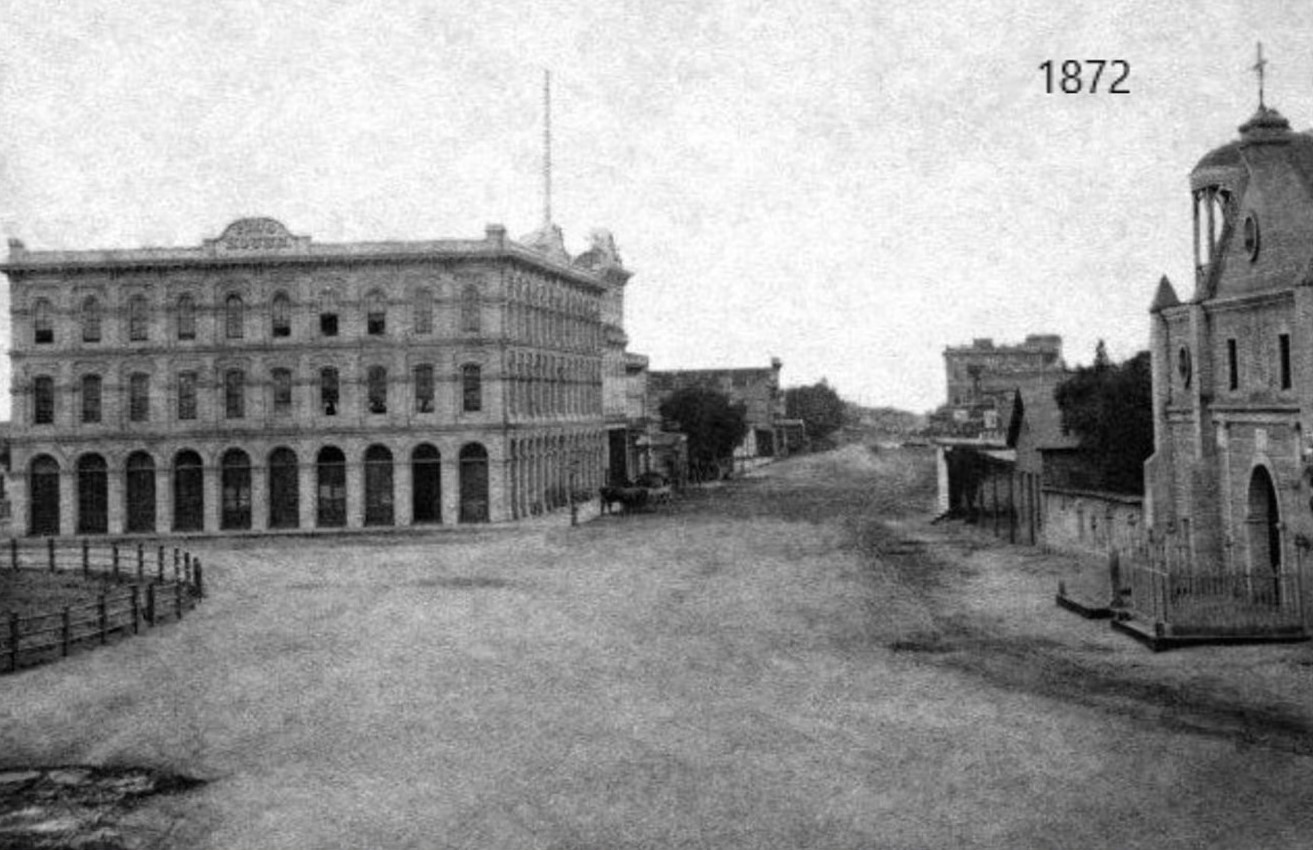 |
|
| (1872)* - Looking south on North Main Street from in front of the Los Angeles Plaza and the Old Plaza Church showing the Pico House and, behind it, the Merced Theatre. In the distance can be seen the Temple Block where today's City Hall Stands. |
Historical Notes Click HERE to see a Then and Now comparison of the above scene. |
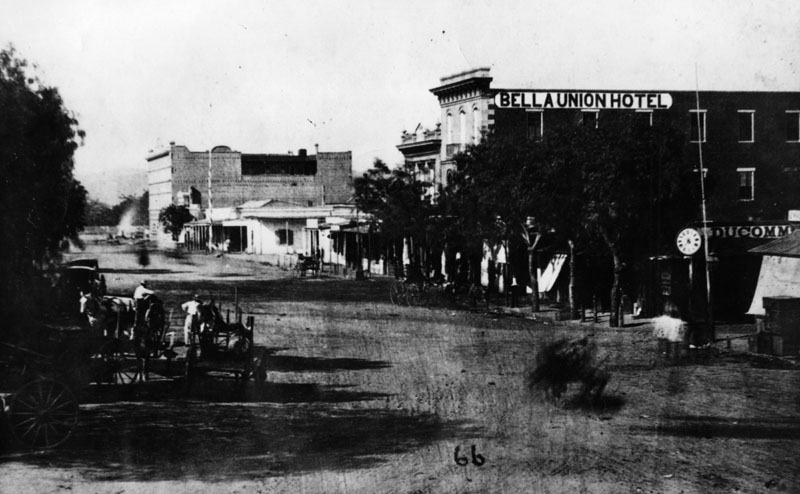 |
|
| (ca. 1870)* - Early view of the 300 block of North Main Street and beyond (view is looking North). Two large buildings stand out; the Pico House on the left and the Bella Union Hotel on the right. The Pico House is located one block north, across the street from the Los Angeles Plaza. It was built in 1870 by Pio Pico, the last Governor of Alta California under Mexican rule. Click HERE to see a Then and Now comparison of the above scene. |
Historical Notes The 300 block of North Main Street was an important part of Los Angeles history as early as the mid-1800s. It was considered the uptown commercial heart of the old city and was always buzzing with activity. Built there was Los Angeles’ first hotel, the Bella Union, which was long a social and political center. The first county courthouse was in the adobe hotel, where court was held in rented rooms from 1850 to 1852. Beginning in 1858, it was the region's transportation hub. The Overland Mail Company operated by John Butterfield (the founder of American Express) rented space for a station. The Wells, Fargo and Company also had their office here and Phineas Banning operated coaches to Wilmington and San Bernardino from the hotel. Just north of the two-story Bella Union was the Pico Building, built by Pio Pico in 1868 (two years before the Pico House). In 1871, the building became home to the Farmers & Merchants Bank, the first incorporated bank in Los Angeles. |
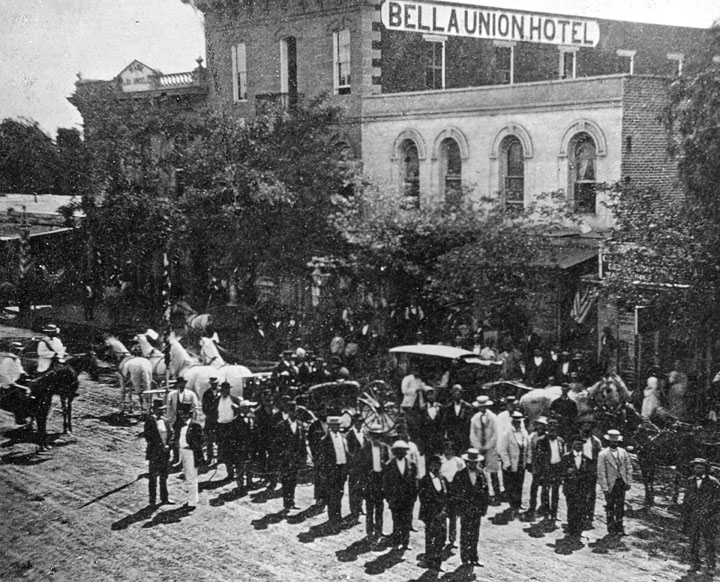 |
|
| (1871)* - A 4th of July parade on North Main Street of the Veterans of the War of 1812. Men are seen in two lines standing in the street, horses and carriages waiting and people on the sidelines. The Bella Union Hotel in the background is partially obscured by trees. |
Historical Notes The Bella Union Hotel was considered the first hotel in Los Angeles. In the 1840s, a one-story adobe owned by Benjamin Davis Wilson stood there. It later became the last capitol of Mexican Alta California. The building served as quarters for American troops in the late 1840s, a saloon, a courthouse (LA's 1st), and a commercial coach hub operated by Phineas Banning. In 1851, a second story was added, and a third in 1869.* The area in front of the the Bella Union Hotel was long used as a social and political center. Here, on October 7, 1858, the first Butterfield Overland Mail stage from the east arrived 21 days after leaving St. Louis. Warren Hall was the driver, and Waterman Ormsby, a reporter, the only through passenger.*^* The Bella Union Hotel became the Clarenden Hotel in 1873 and the St. Charles Hotel in 1875. Pico's Building, to the left, was the original home of Farmers and Merchants Bank (later merged into Security Pacific Bank). The Bella Unioin Hotel site was designated California Historical Landmark No. 656. * |
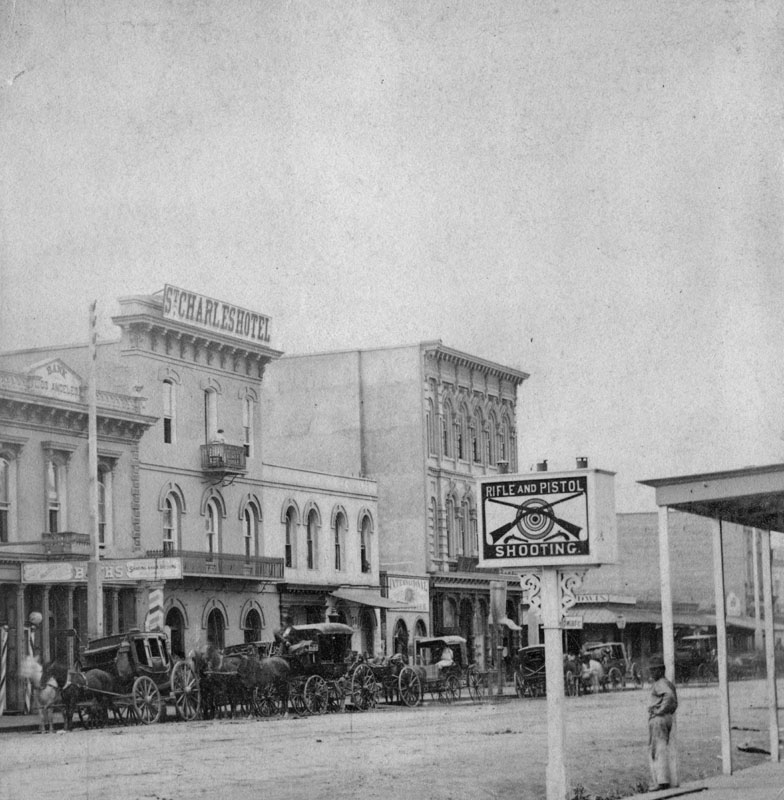 |
|
| (ca. 1875)* - View looking southeast showing St. Charles Hotel, originally the Bella Union Hotel. Horses and buggies are lined up along the street. In the foreground a sign reads, “Rifle and Pistol Shooting,” a reminder that Los Angeles was a Western frontier town. |
Historical Notes In its early years, Los Angeles was a city of violence. Murders, riots, slaughter on the highways, and crimes of passion were daily occurrences. During the years 1834 – 1874, the first and last recorded lynchings in the city, the citizens resorted with distressing frequency to vigilant actions. During the 1850s, almost every issue of the local press noted several murders. Death by violence seems so common that these crimes seldom received more than a few lines. Even in the 1870s, when the local paper was daily, most issues carried items about assaults, cuttings, and, less frequently, a murder. ++ |
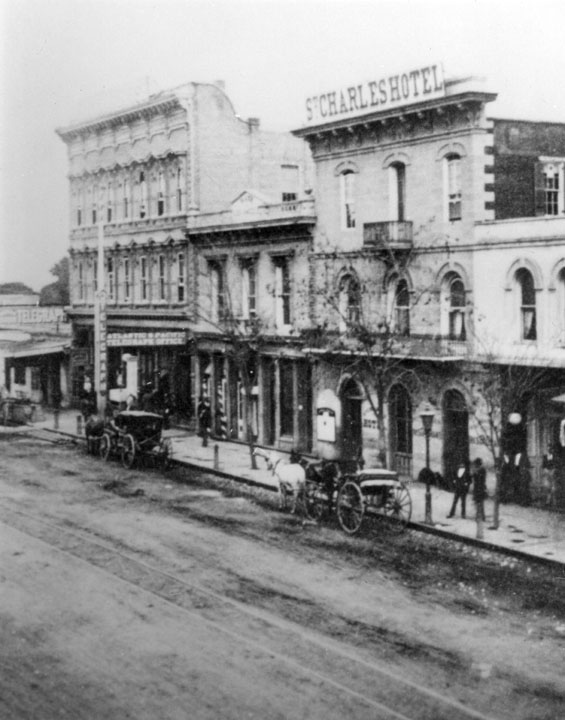 |
|
| (1880)* - View looking northeast showing the St. Charles Hotel, originally the Bella Union Hotel. To the left (north) stands the Farmers and Merchants Bank (previously the Pico Building). Further north is the 3-story Grand Central Hotel, built in 1876. |
Historical Notes The two-story building to the north of the St. Charles Hotel (seen above) is the Pico Building, built by Pio Pico in 1868 (two years before the Pico House). In 1871, the building became home to the Farmers & Merchants Bank, the first incorporated bank in the Los Angeles, directed by former California Governor John G. Downey.^*^ In 1871, Isaias W. Hellman and John G. Downey formed the Farmers and Merchants Bank, which became Los Angeles' first successful bank. Hellman lent the money that allowed Harrison Gray Otis to buy the Los Angeles Times and Edward Doheny and Charles Canfield to drill for oil.*^ |
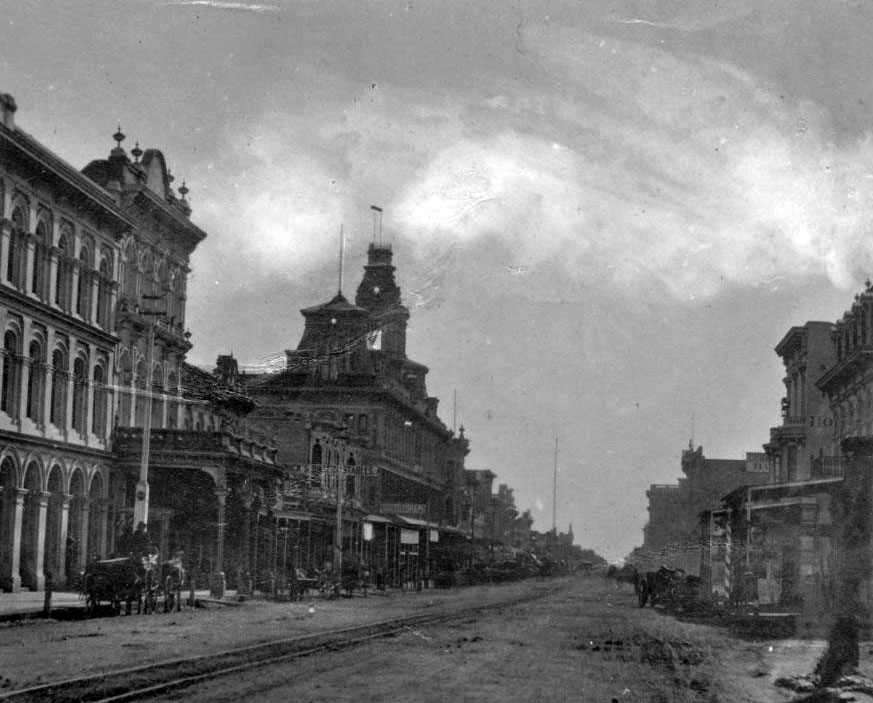 |
|
| (ca. 1878)^^ - View of Main Street looking south from near the LA Plaza. A horse-drawn wagon with two men in it is parked in front of the Pico House near the Merced Theater on the left. The road is unpaved and a streetcar track runs down the middle. Both sides of the street are lined with imposingly large buildings. At center, on the left side of the street, is an especially large building topped by three prominent towers. It is the Baker Building (referred to as Baker Block), built in 1878. |
Historical Notes The ornate three-story Baker Block was completed in 1878 by Colonel Robert S. Baker. It was located at the north end of the 300 Main St. block at the southeast corner of Main and Arcadia streets. For a number of years, the building housed offices, shops, and apartments. As a point of interest, Colonel Robert Baker married Abel Stearn’s widow, Arcadia Bandini de Stearns, in 1874 (three years after Stearn’s death in 1871). The Baker Block was built on the same site as the Stearns Adobe. |
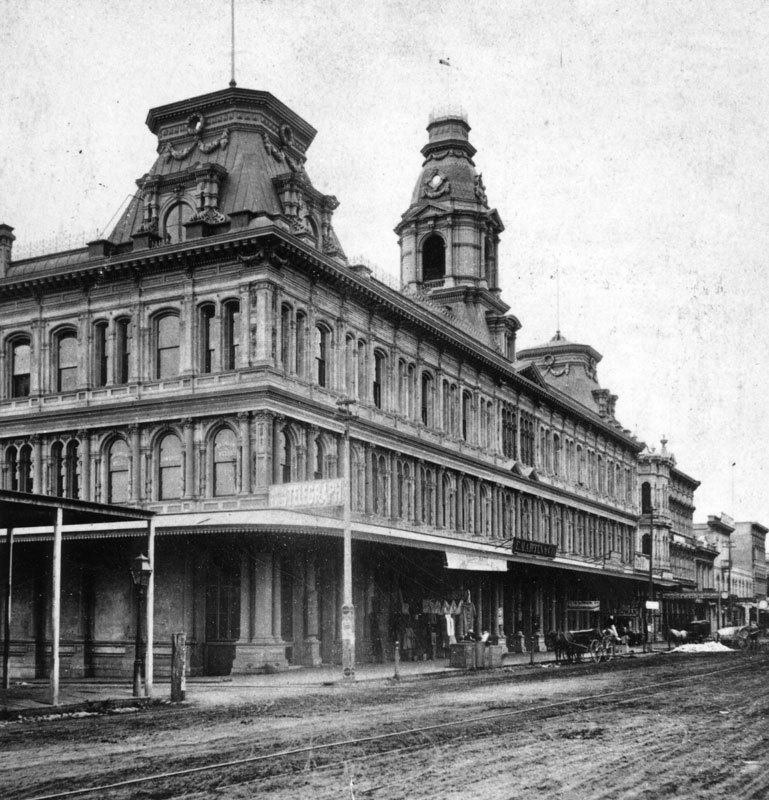 |
|
| (1880)* - Built on the former site of the Abel Stearns Adobe (S/E corner of Main and Arcadia streets) , the Baker Block was prominent in early Los Angeles. Note the telegraph office has a sign at the corner of the building. |
Historical Notes At the time of its completion, the Baker Block was reputedly the largest and most expensive structure to have been built south of San Francisco. Among other achievements, it is also believed to have been Los Angeles’ first steel-framed building, and it's first to have tiled floors. For many years it was considered the best thing in town, an early microcosm of city life. Offices for lawyers, physicians and businessmen were on the second floor and on the top floor were the City's most costly and fashionable apartments. |
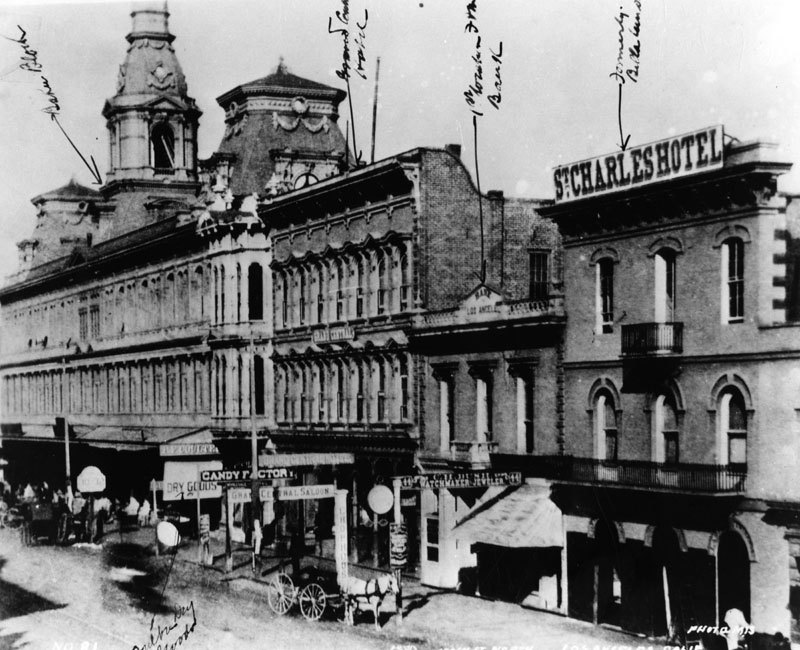 |
|
| (ca. 1880)* - View of North Main Street showing (from L to R): Baker Block, Downey Building, Grand Central Hotel, Pico Building (original home of Farmers and Merchants Bank), and the St. Charles Hotel (formerly the Bella Union Hotel). |
Historical Notes The three-story Grand Central Hotel at 326 North Main Street was completed around 1877. Major construction came to its climax on the 300 blk of Main Street in the following year with the opening of the Baker Block, on the left. The slim, three-story building nestled between the Baker Block and Gand Central Hotel was developed by the ever active Governor Downey, and finished around 1878.^*^ |
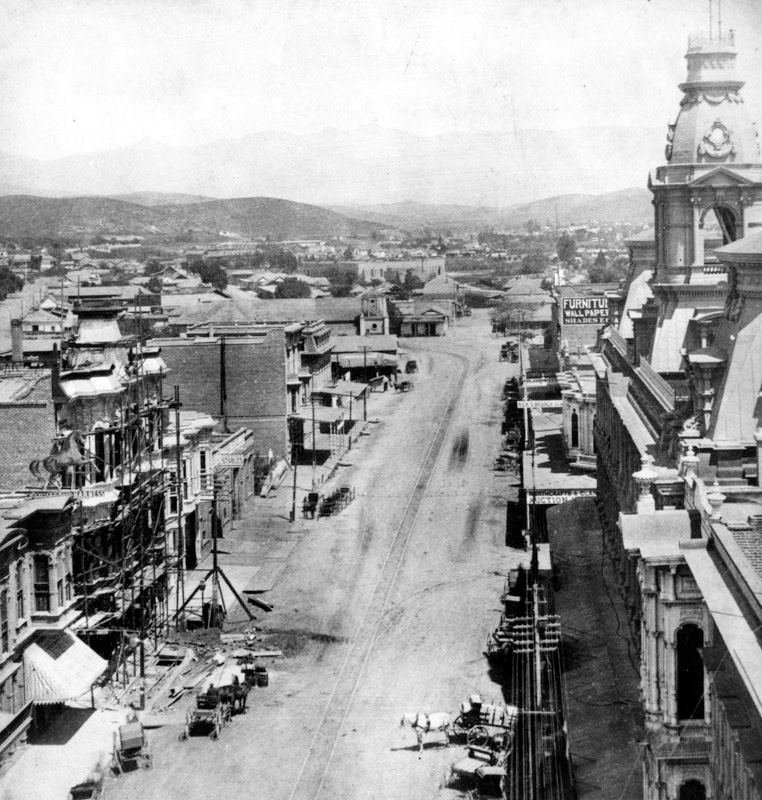 |
|
| (ca. 1880)^ - View looking north on Main Street from the Downey Building located just south of the Baker Block on the 300 block of N. Main Street. In the distance can be seen the Old Plaza Church where Main Street veers to the left. Telephone/telgraph lines can be seen on both sides of the street. |
Historical Notes Alexander Graham Bell invented the telephone in the late 1870's and it didn't take long for Los Angeles to adopt the new technology. In 1879, the Los Angeles Telephone Company was formed and it began offering telephone service in the area of what is now Downtown Los Angeles. This was just one year after the very first North America telephone exchange was installed in New Haven, Connecticut (January, 1878). The Los Angeles Telephone Company originally started with only seven subscribers.^*^*^ |
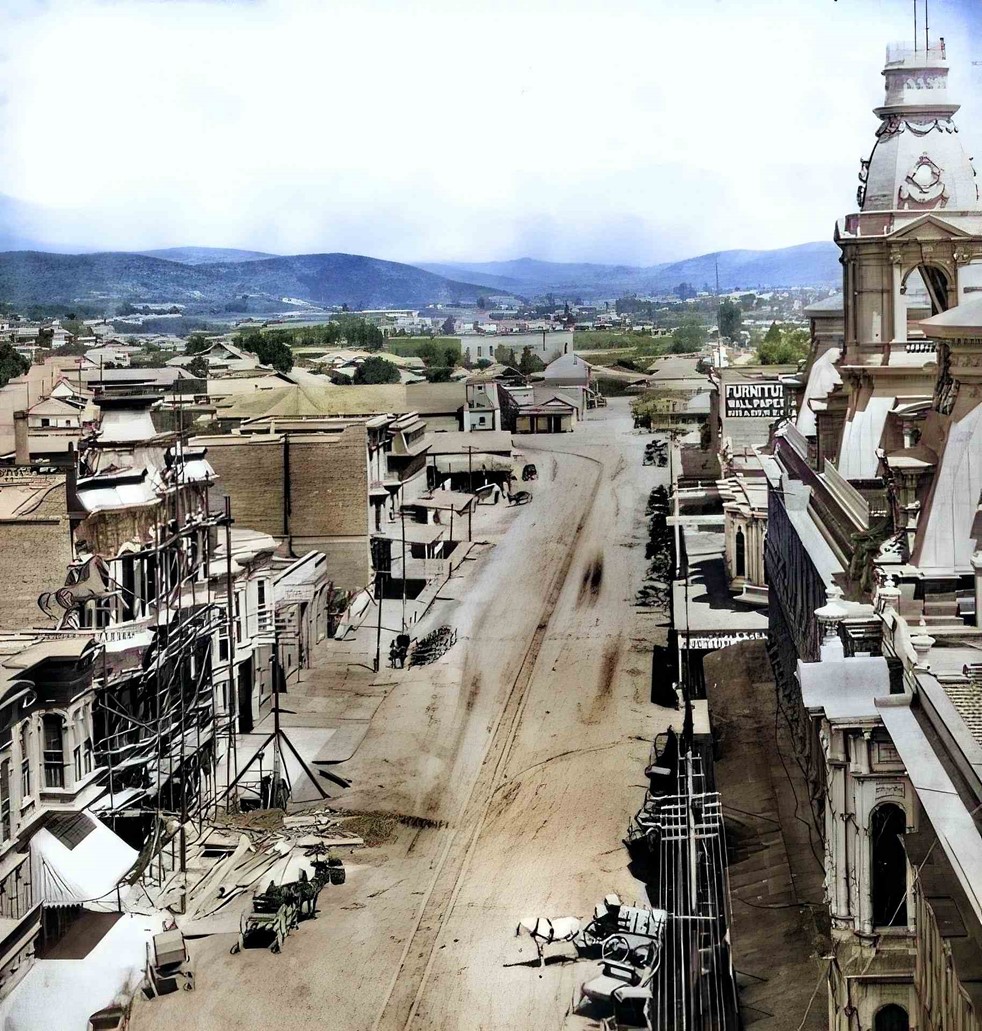 |
|
| (ca. 1880)^ - View looking north on Main Street from the Downey Building located just south of the Baker Block on the 300 block of N. Main Street. In the distance can be seen the Old Plaza Church where Main Street veers to the left. Telephone/telgraph lines can be seen on both sides of the street. (AI image enhancement and colorization by Richard Holoff) |
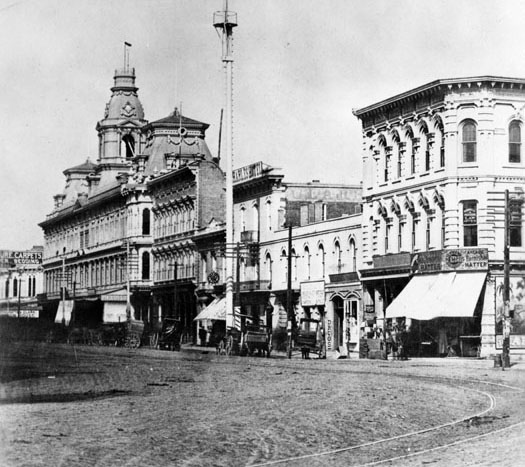 |
|
| (ca. 1882)**- Street view looking north showing the 300 block of N. Main Street. The Ducommun Building stands on the northeast corner of Main and Commercial streets at right. The tall pole at center is one of the City's first 150-ft tall electric light poles installed in 1882. A platform can be seen at what appears to be the top of the pole, however, it actually extends up another 75 feet. |
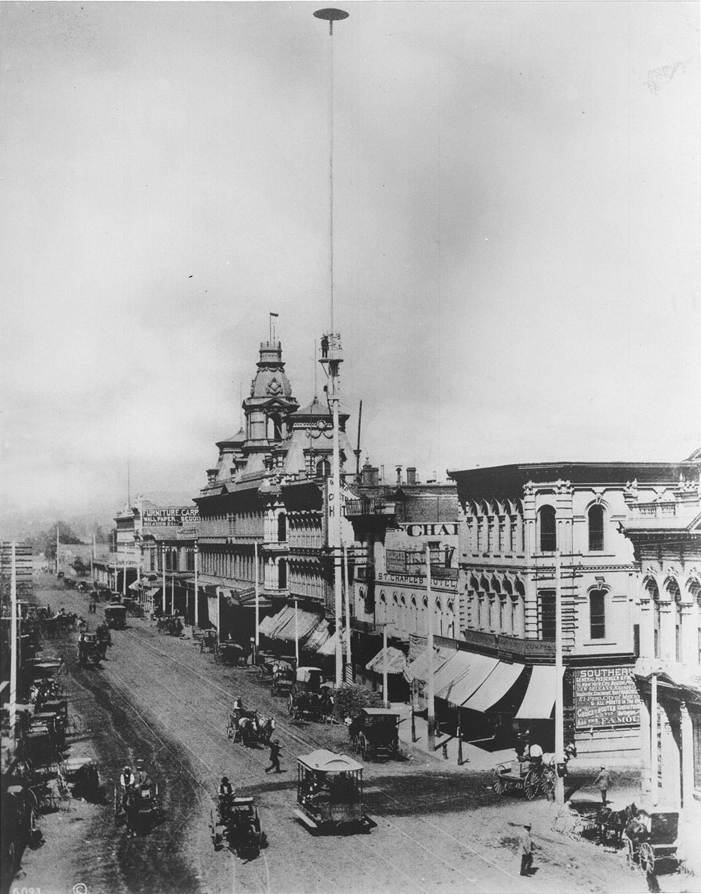 |
|
| (ca. 1882)** - Another look at one of Los Angeles' first electric light poles. View is of the buildings on the east side of North Main Street from the Ducommun Building at Commercial Street (right) to the Baker Block at , at near right, to looking toward the Baker Block at . A man can be seen standing on a platform half way up the street light mast. Click HERE to see more in Early Los Angeles Street Lights |
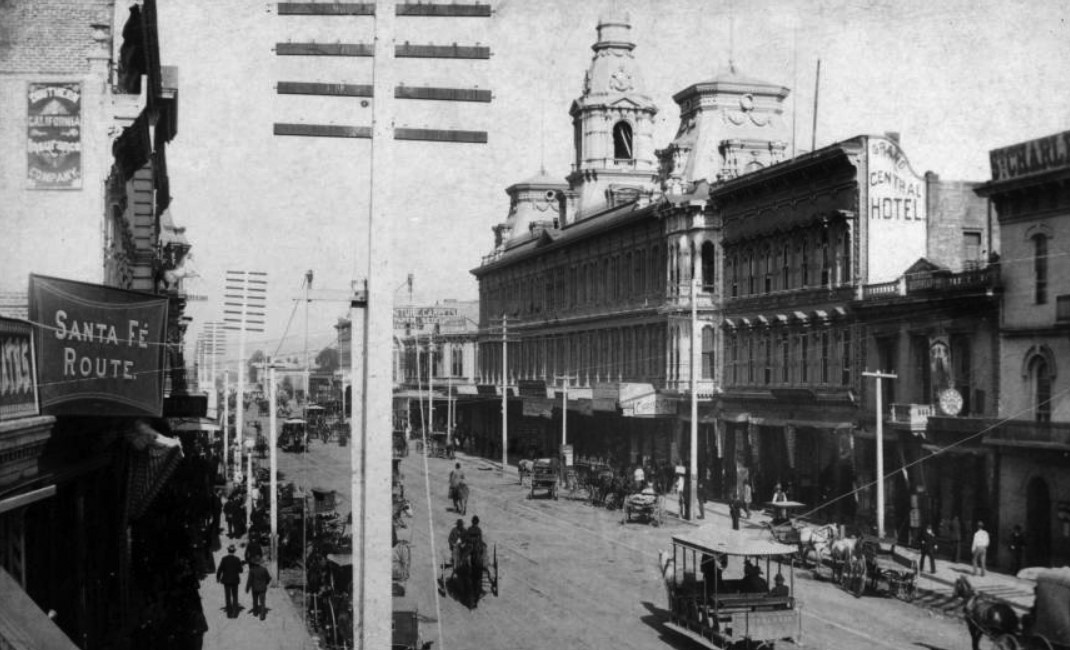 |
|
| (1888)^^ - View looking north on the 300 block of Main Street. The street is filled with horse-drawn streetcars, wagons, and a lone horseback rider. On the right can be seen the Baker Block, Downey Building, Grand Central Hotel, the 2-story Pico Building, and the St. Carles Hotel (formerly the Bella Union Hotel). |
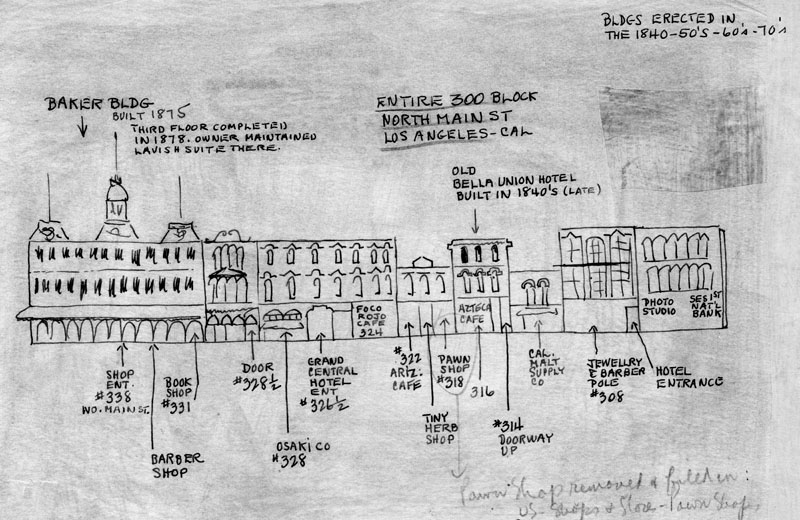 |
|
| (n.d.)* - Drawing of North Main Street, showing the location of the businesses in the entire 300 block, starting with the Baker Block on the left and extending to the Duccomun Building on the right. |
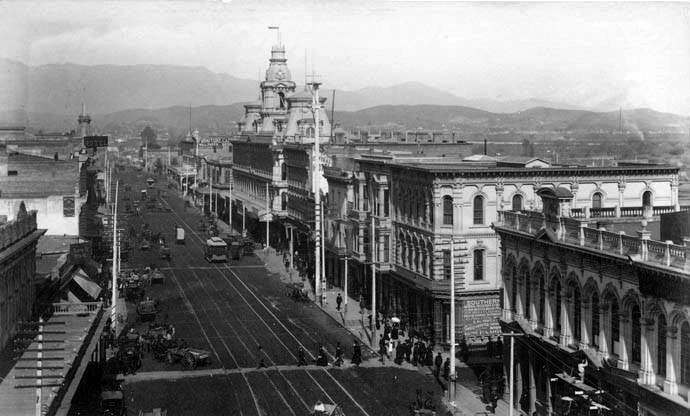 |
|
| (1898)*** - Postcard view of the 300 block of Main Street looking north on a clear day. Pedestrians are seen crossing the streetcar tracks on Main Street in front of the Ducommun Building. |
Historical Notes By the 1890s, as a result of the business center’s continuous southward expansion, North Main Street was beginning to fall into a long, slow decline. On the other hand, its tightly knit blocks were left largely untouched by new development while they continued to support active commercial uses. |
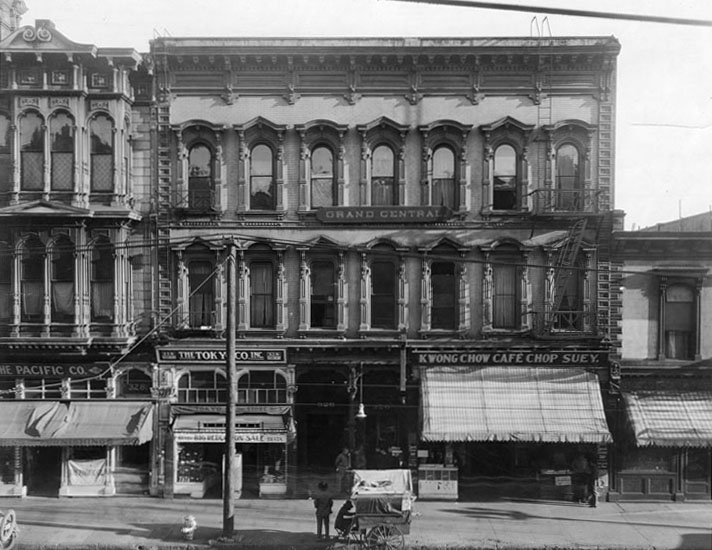 |
|
| (ca. 1910s)* - View showing the Grand Central Hotel, at 326 N. Main Street, with businesses on the ground floor such as Tokyo Co. Inc. and Kwong Chow Cafe. A man in a push cart is directly in front. To the left ia the 3-story Downey Building and further to the left (out of view) is the Baker Block. To the right is the 2-story Pico Building. |
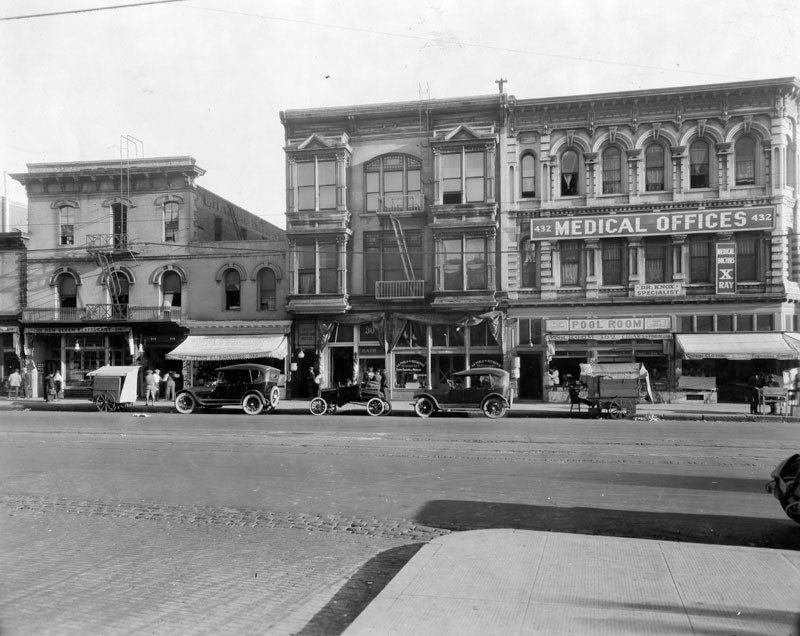 |
|
| (1920s)* - View showing the east side of the 300 block of N. Main Street, north from the corner of Commercial Street. The Ducommun Building is seen at right with the 'Medical Offices' sign on its face and the St. Charles Hotel is at far left. Other business establishments seen in photo include the New Queen Restaurant, La Perla de Occidente Restaurant, a pool room, and clothing shops. |
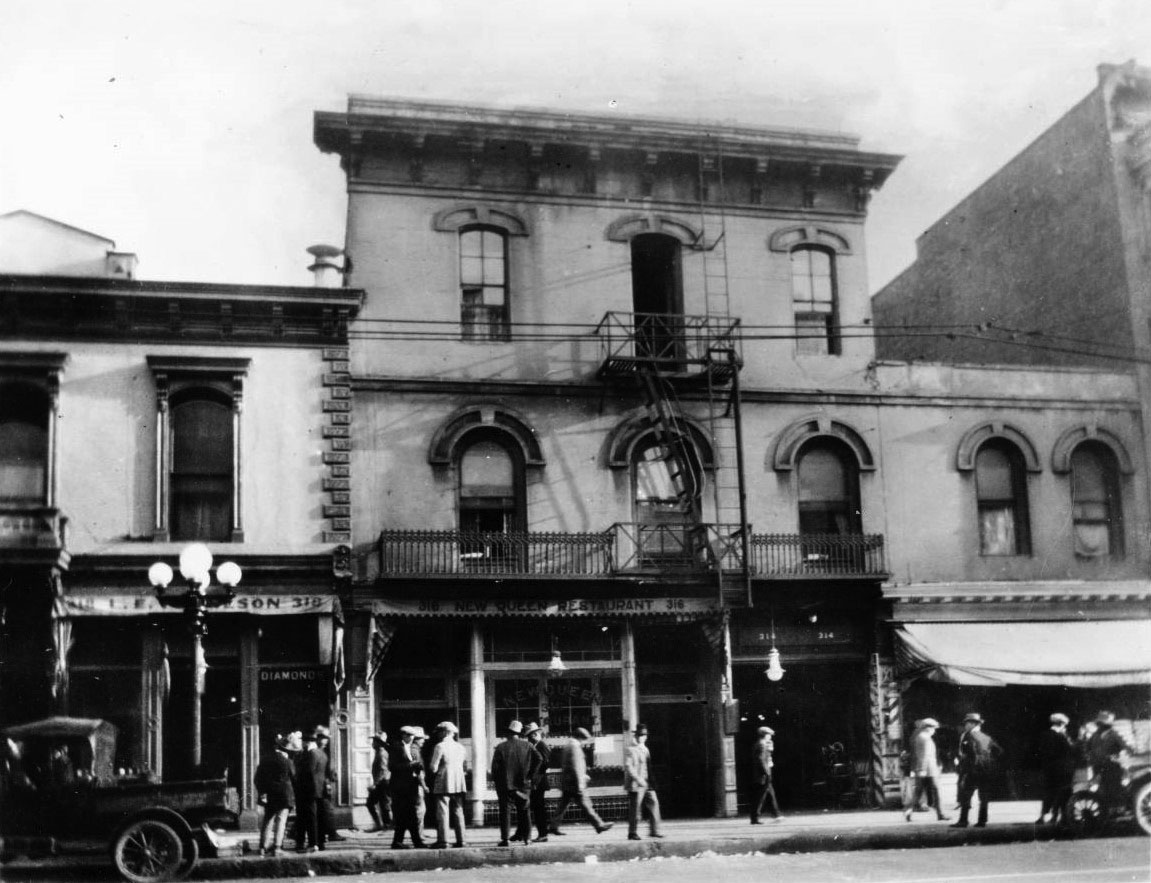 |
|
| (ca 1926)^^ – View showing several people crowded on the sidewalk in front of the St. Charles Hotel (old Bella Union Hotel) on N. Main Street. The New Queen Restaurant occupies the first floor of the hotel. |
Historical Notes Constructed in 1835, the Bella Union Hotel has a long, rich history. It served as the County Courthouse until October 1851, and in 1860 was the location of a champagne fete celebrating the connection of San Francisco and Los Angeles by telegraph.* |
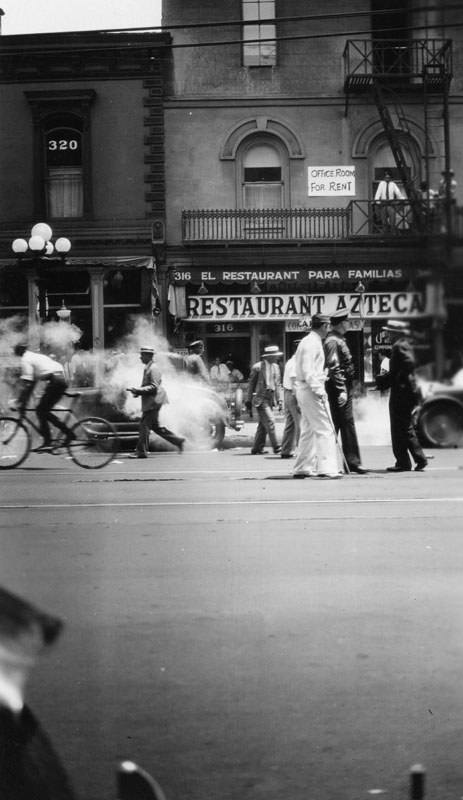 |
|
| (1920s)* - View of a busy North Main Street in front of the Azteca Restaurant, El Restaurant Para Familias', as seen from across the street. The restaurant, which in previous photo was the New Queen Restaurant, is located on the street floor of the old Bella Union Hotel. A sign on the second floor reads: Office Room For Rent. |
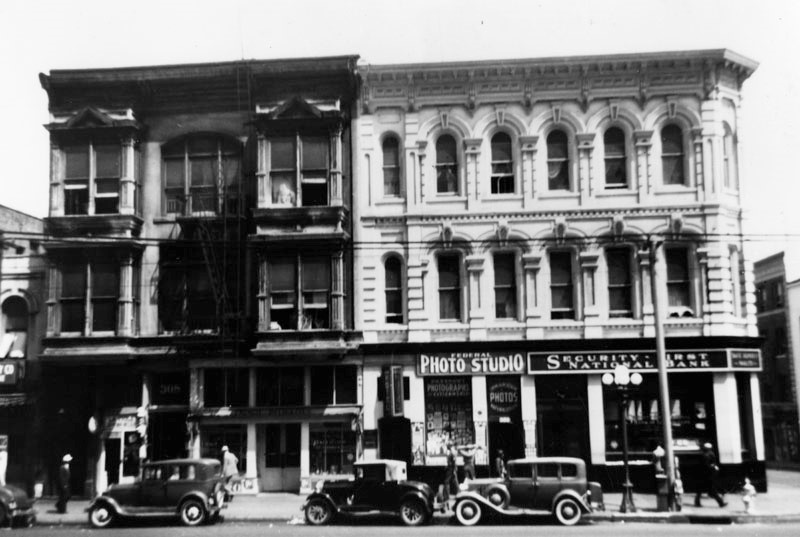 |
|
| (ca. 1930)* – View of the west side of North Main Street. Security First National Bank now occupies part of the Ducommun Building on the northeast corner of Main and Commercial streets. |
Historical Notes The Security First National Bank of Los Angeles became the Security Pacific National Bank and is now Bank of America. The Farmers and Merchants Bank was the oldest bank in Southern California from 1871 until 1956 when it was merged into the Security First National Bank of Los Angeles.* |
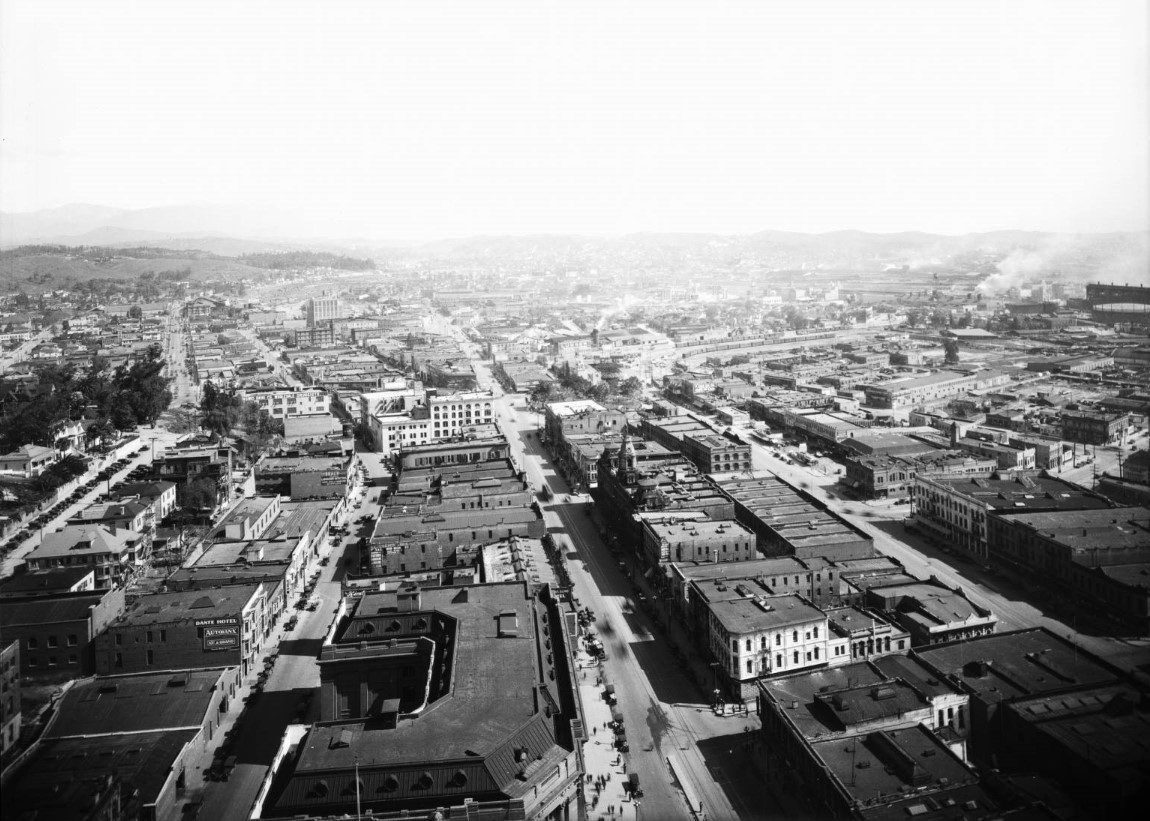 |
|
| (ca. 1930)^^ - Birdseye view looking north-east showing North Main Street as seen from City Hall. The large building in the foreground is the old Federal Building and Post Office (N/W corner of N. Main and Temple streets). The 300 block of Main Street is in clear view. |
.jpg) |
|
| (ca. 1930)^^ - Aerial view showing a closer look at the historic 300 block of North Main Street from Arcadia Street to Commercial Street. |
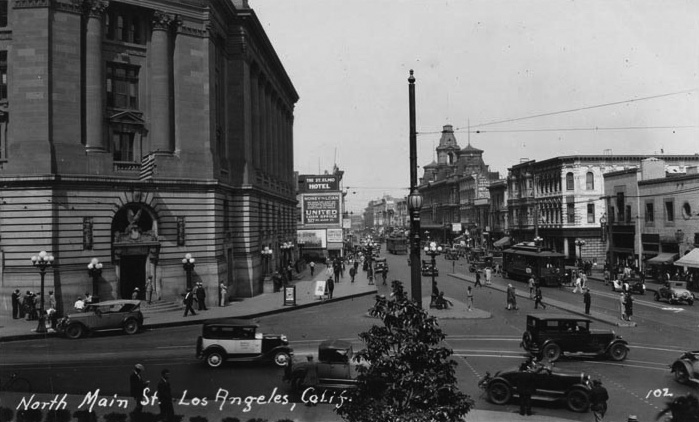 |
|
| (1932)^*# - Postcard street view of North Main Street as seen from the base of Los Angeles City Hall at Temple Street. The entire 300 block of N. Main Street, from Baker Block to the Ducommun Building, can be seen here. The old Federal Building and Post Office stands on the northwest corner. |
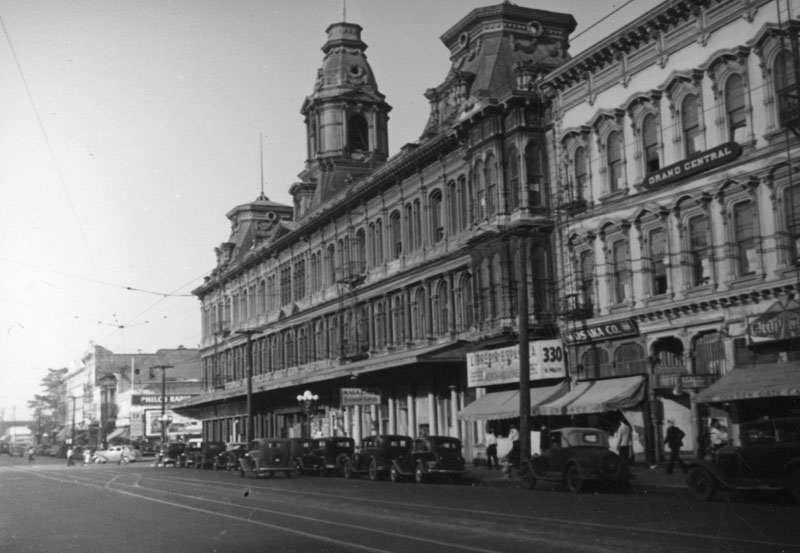 |
|
| (ca. 1936)* - Looking across N. Main Street (foreground) towards the French Second Empire style Baker Block, on the southeast corner at Arcadia Street (lower left), and the Grand Central Hotel (right). Between the two sits a very narrow Doheny Building. |
Historical Notes The Baker Block had lost much of its luster by the turn of the century, and by the time it was purchased by Goodwill Industries in 1919, it was all too clear that its days were numbered. As cruel fate would have it, the faded landmark was slated to give way to one of the most mundane projects in the 1930 Civic Center plan: a two-block extension of Aliso Street from Los Angeles Street to Broadway.^*^ Despite plans to relocate the structure for another purpose, the city purchased the Baker Block from Goodwill in 1941 and demolished the building a year later. U.S. Route 101 now runs beneath where these buildings once stood.* |
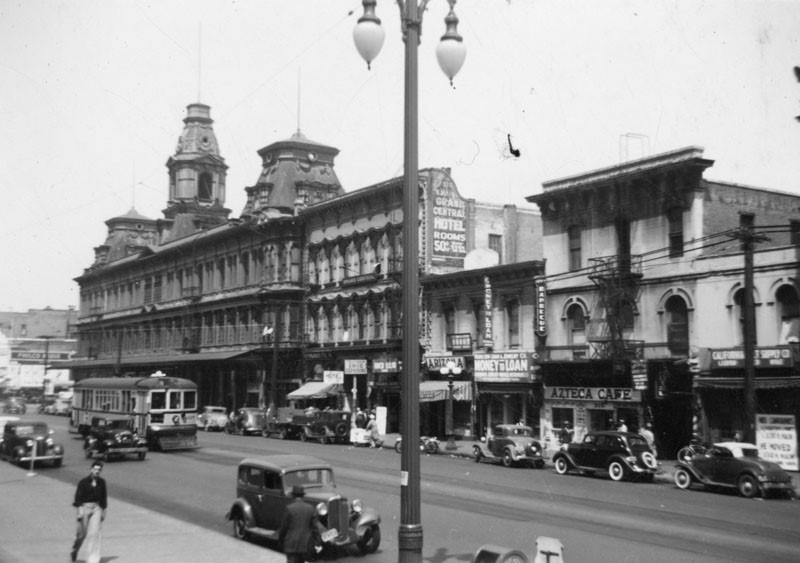 |
|
| (ca. 1940)* - Looking northeast showing the buildings on the 300 block of North Main Street shortly before their demoliton. |
Historical Notes Well into the 20th century, the old buildings on the 300 block of North Main Street were a vivid testament to Los Angeles’ early history, from its humble beginnings to its astonishing growth during the Reconstruction years. Behind the “Azteca” sign on the right side of the top photograph is the Bella Union Hotel, considered to be the city’s first hotel. Completed sometime during the 1840s, it was one of downtown’s greatest landmarks for several decades, and was later expanded to two, then three stories. The two-story building to its left is the Pico Building, built by Pio Pico in 1868 (two years before the Pico House). In 1871, the building became home to the Farmers & Merchants Bank, the first incorporated bank in the Los Angeles, directed by former California Governor John G. Downey.^*^ |
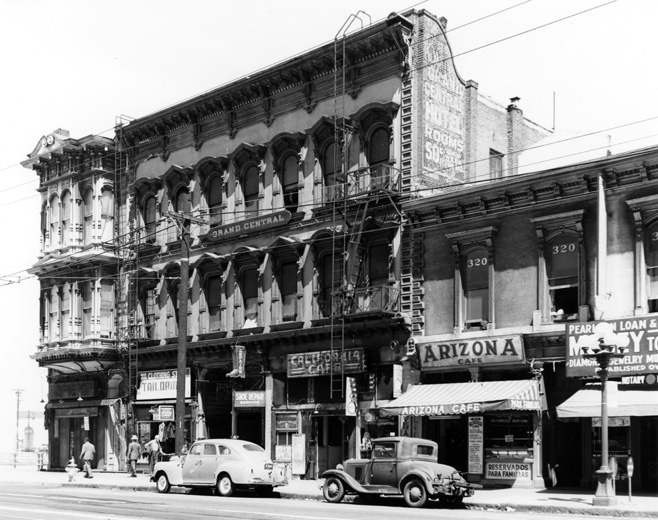 |
|
| (1940s)^*# - View of Maint Street north of Commercial Street showing (L to R): the slim Downey Building, Grand Central Hotel and Pico Building (original home of Farmers and Merchants Bank). |
.jpg) |
|
| (ca. 1950)#^ - View showing the last building standing on the 300 block of North Main Street awaiting demolition. It is the slim, three-story Downey Building (built in 1878) that once was nestled between the Baker Block and Grand Central Hotel. |
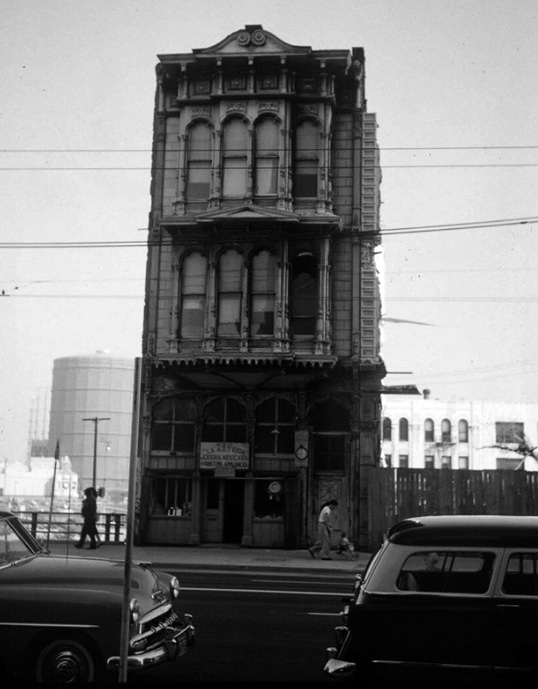 |
|
| (ca. 1950)^.^ - View looking east showing the Downey Building at 330 N. Main Street before its demise. |
Before and After
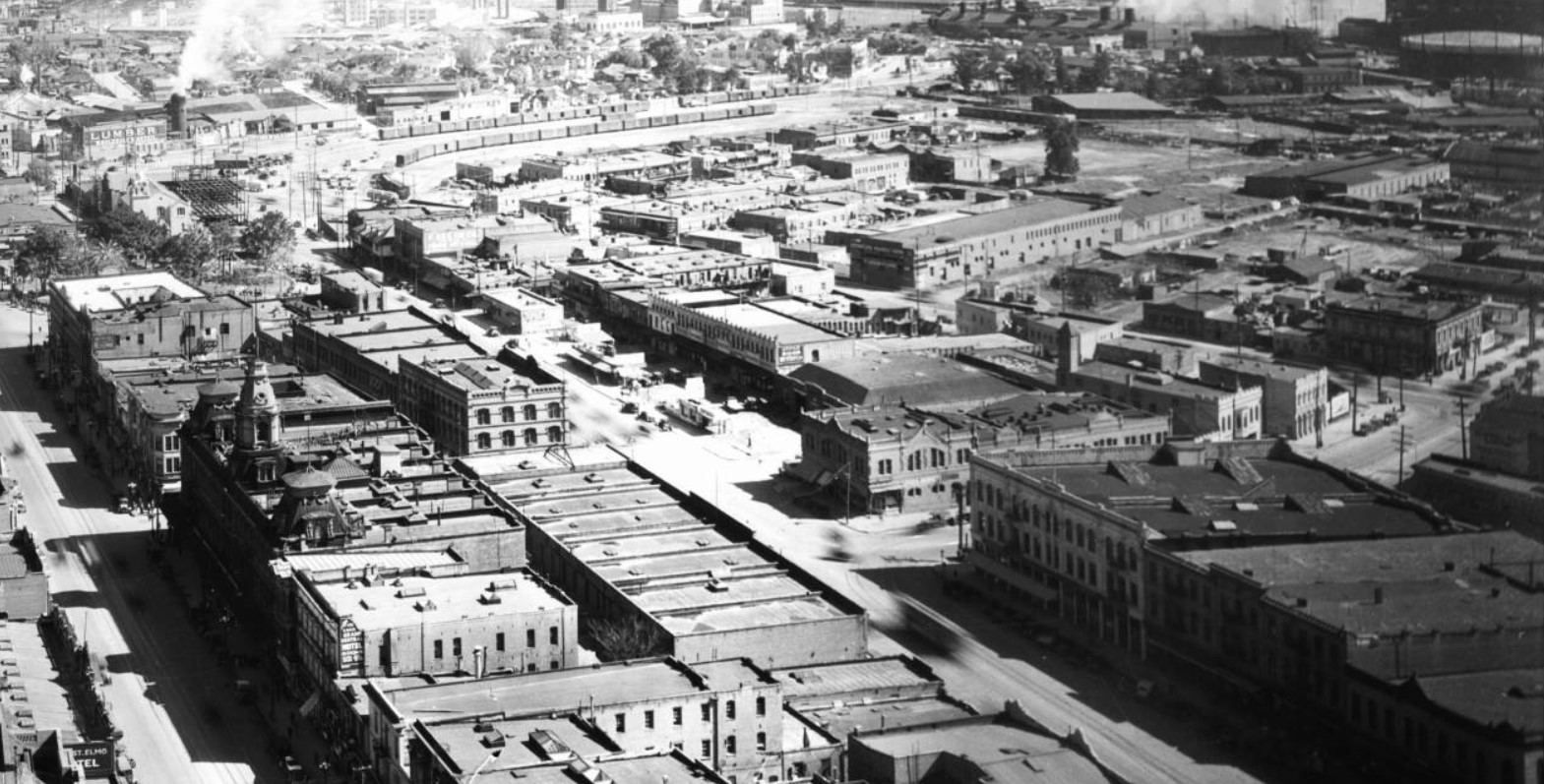 |
|
| (ca. 1930)^^ - View looking northeast from City Hall showing the old part of Los Angeles including the LA Plaza and Chinatown. At left can be seen the ornate Baker Building with its three towers located on the historic 300 block of N. Main Street. Los Angeles Street runs diagonally from lower-right to upper-left. Aliso Street runs from Los Angeles Street at center east and then turns diagonally up. Union Station wasn't completed until 1938 and would be located in the upper right of photo. |
Historical Notes The historic buildings on the 300 block of North Main were demolished to extend Aliso Street from Los Angeles Street to Broadway. Several years later the Hollywood Freeway (Route 101) would be constructed over this new Aliso Street extension. |
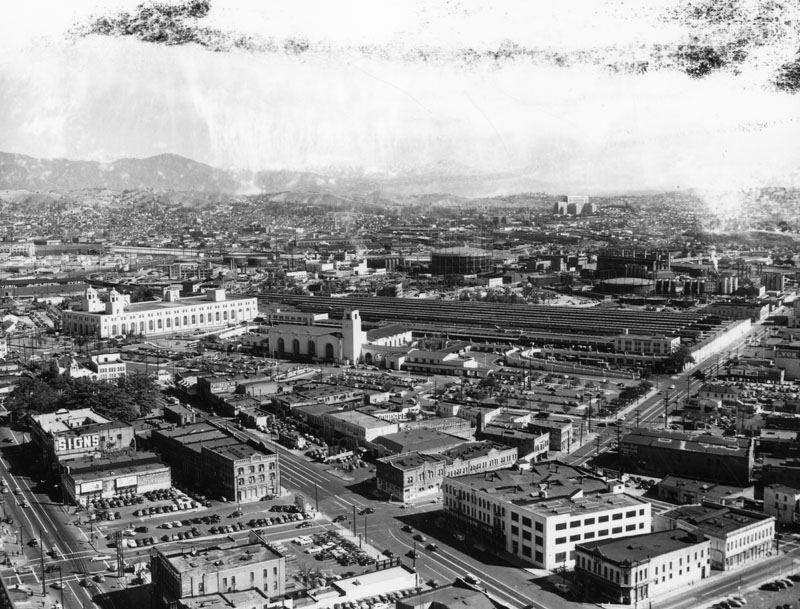 |
|
| (ca. 1951)* - Aerial view of Los Angeles near the Plaza before construction of the Hollywood Freeway with Union Station in the background. The Plaza is seen to the left. The 300 block of North Main Street is at lower left, now consisting of mostly parking lots and the new Aliso Street extension. |
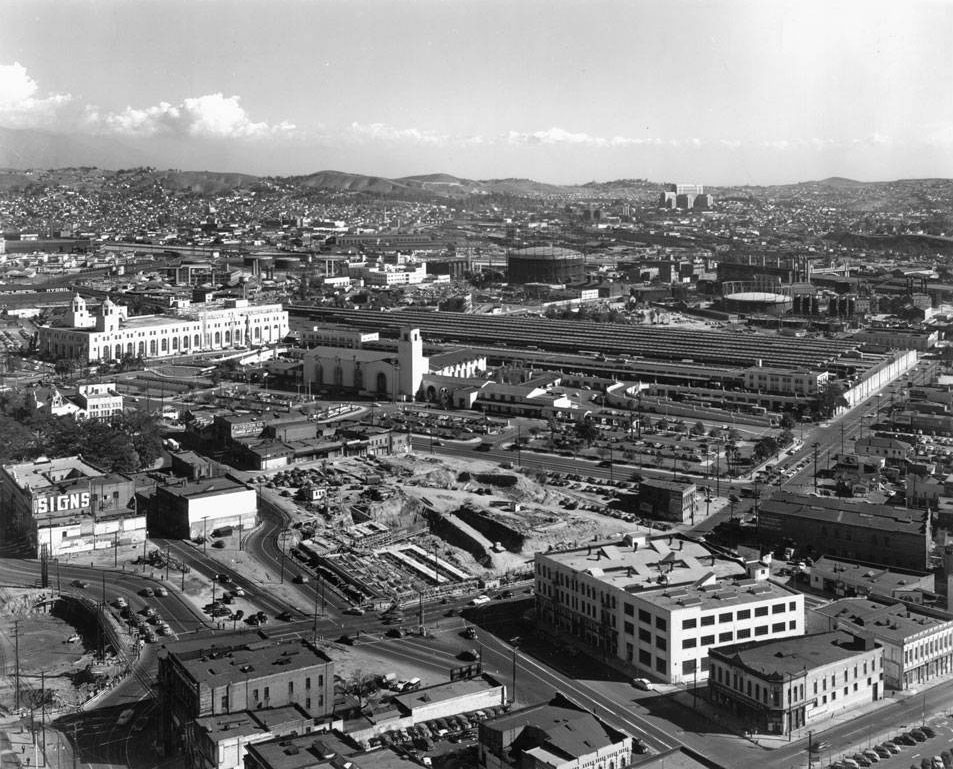 |
|
| (1950s)^^ - Construction of the 101 Freeway begins through the old section of Los Angeles along Aliso Street. The LA Plaza is seen at left-center and the historic 300 block of Main Street at lower left corner. |
Historical Notes The Hollywood Freeway (U.S. Route 101) through downtown Los Angeles was opened in 1954. |
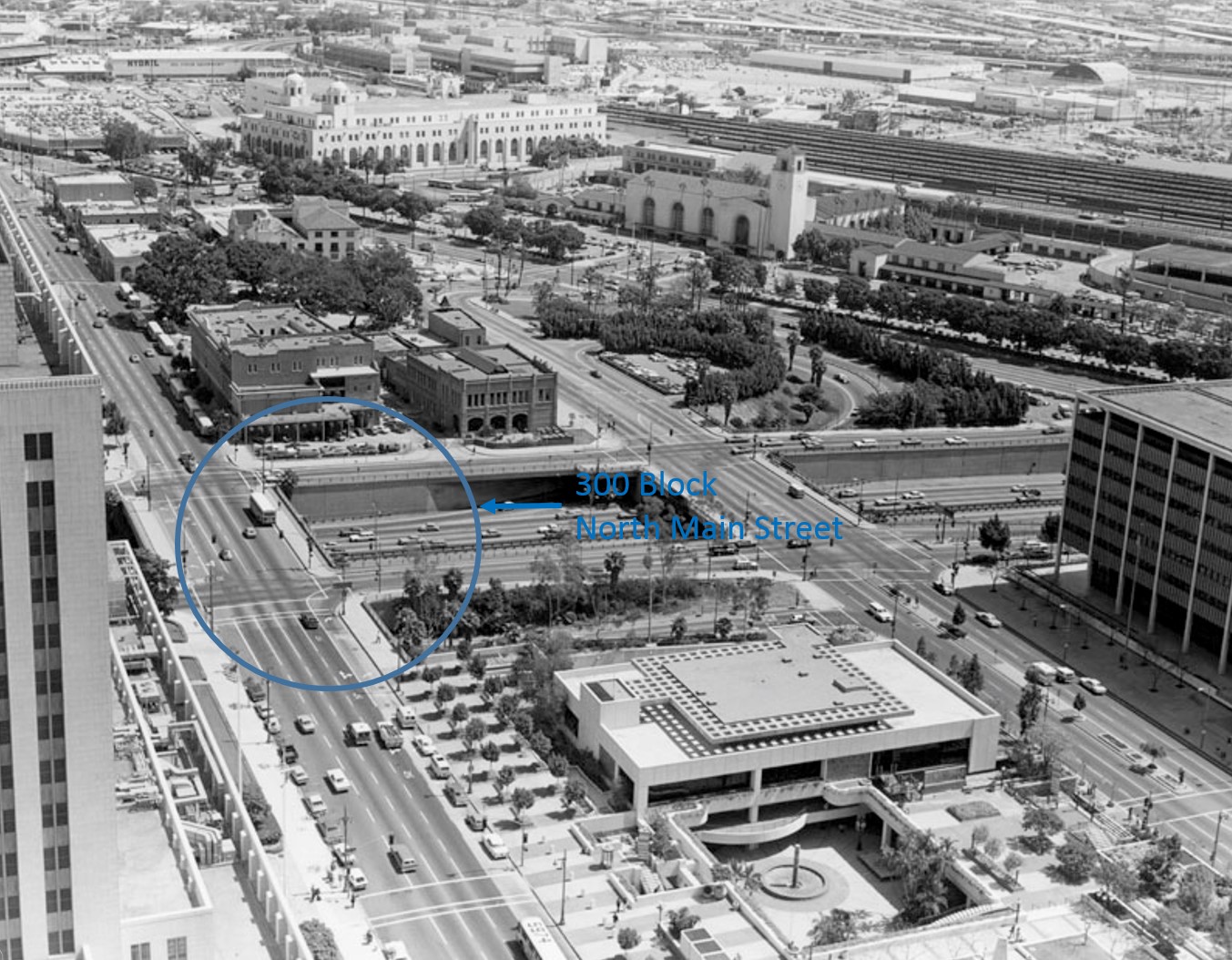 |
|
| (1970s)* - View from City Hall looking down toward the 300 block of North Main Street. The Hollywood Freeway (U.S. Route 101) now runs beneath where the Main Street historic buildings once stood. |
Then and Now
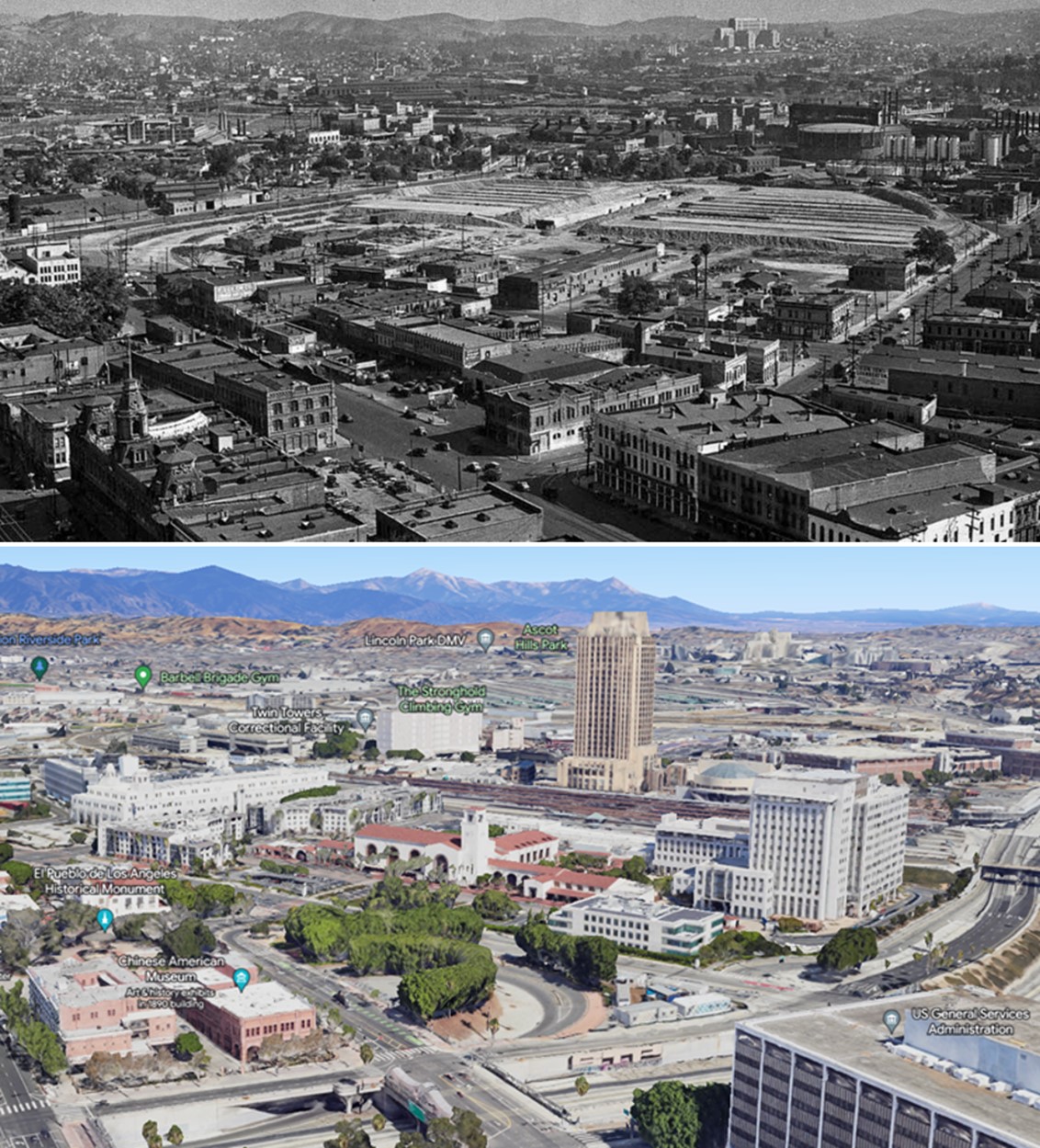 |
|
| (1935 vs 2022)* - Looking down toward Union Station from the top of City Hall. Note the Hollywood Freeway runs through where the Baker Block once stood (lower-left). |
Then and Now
.jpg) |
|
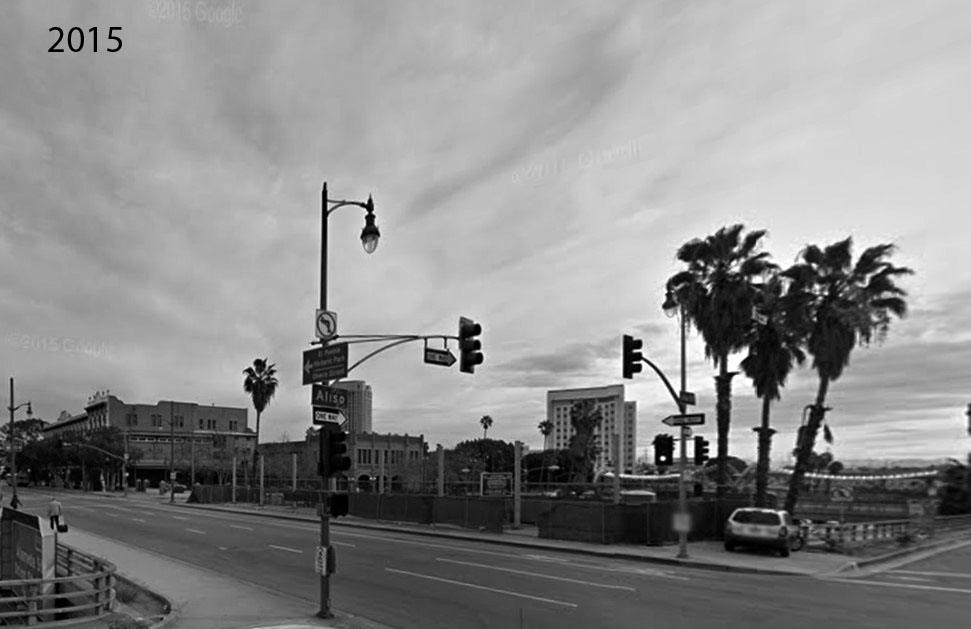 |
|
| (1930s)* - (2015)^* - View of N. Main Street as seen from about the same spot over 70 years later. |
Then and Now
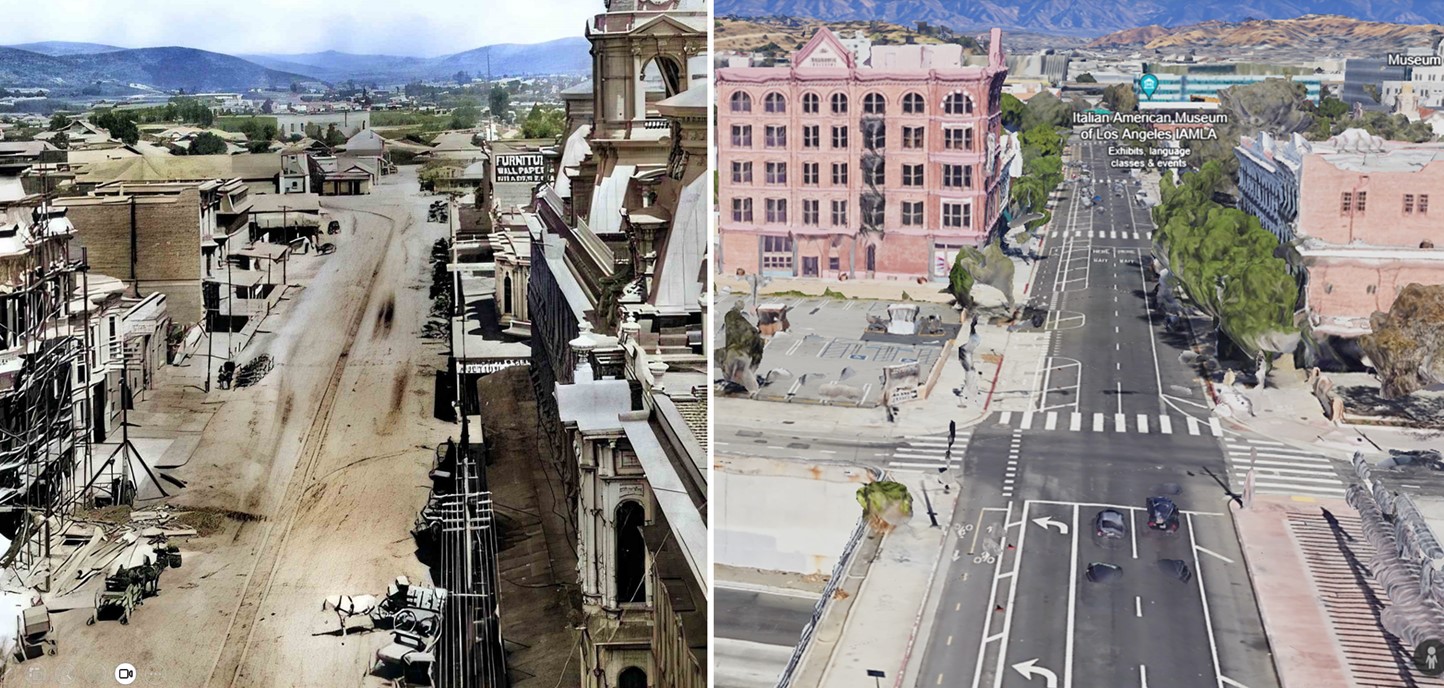 |
|
| (1880 vs 2022)* - Looking north on the 300 Block of Main Street. |
Then and Now
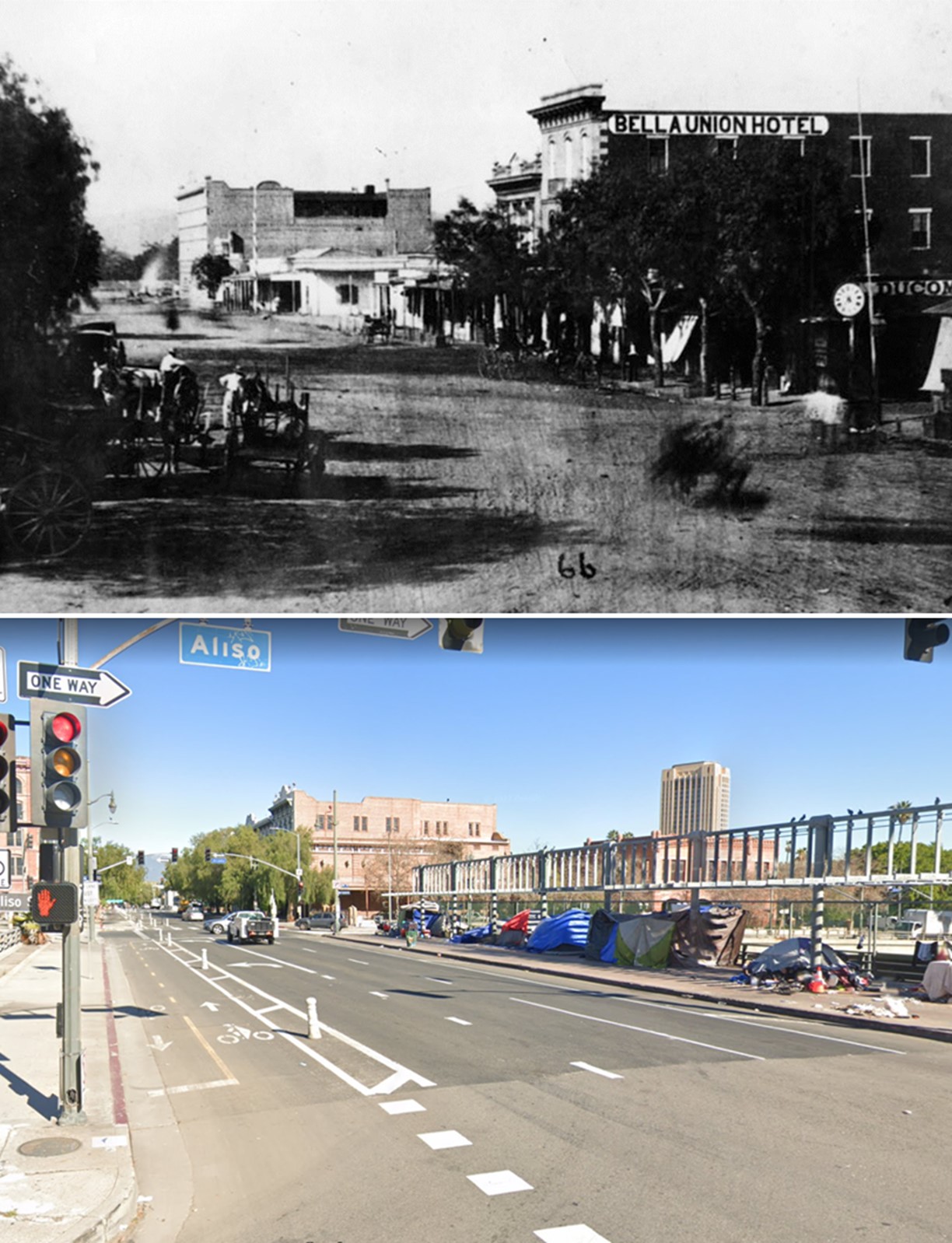 |
|
| (1870 vs 2022) – Looking North on Main Street from Aliso Street in Old Downtown Los Angeles. |
Then and Now
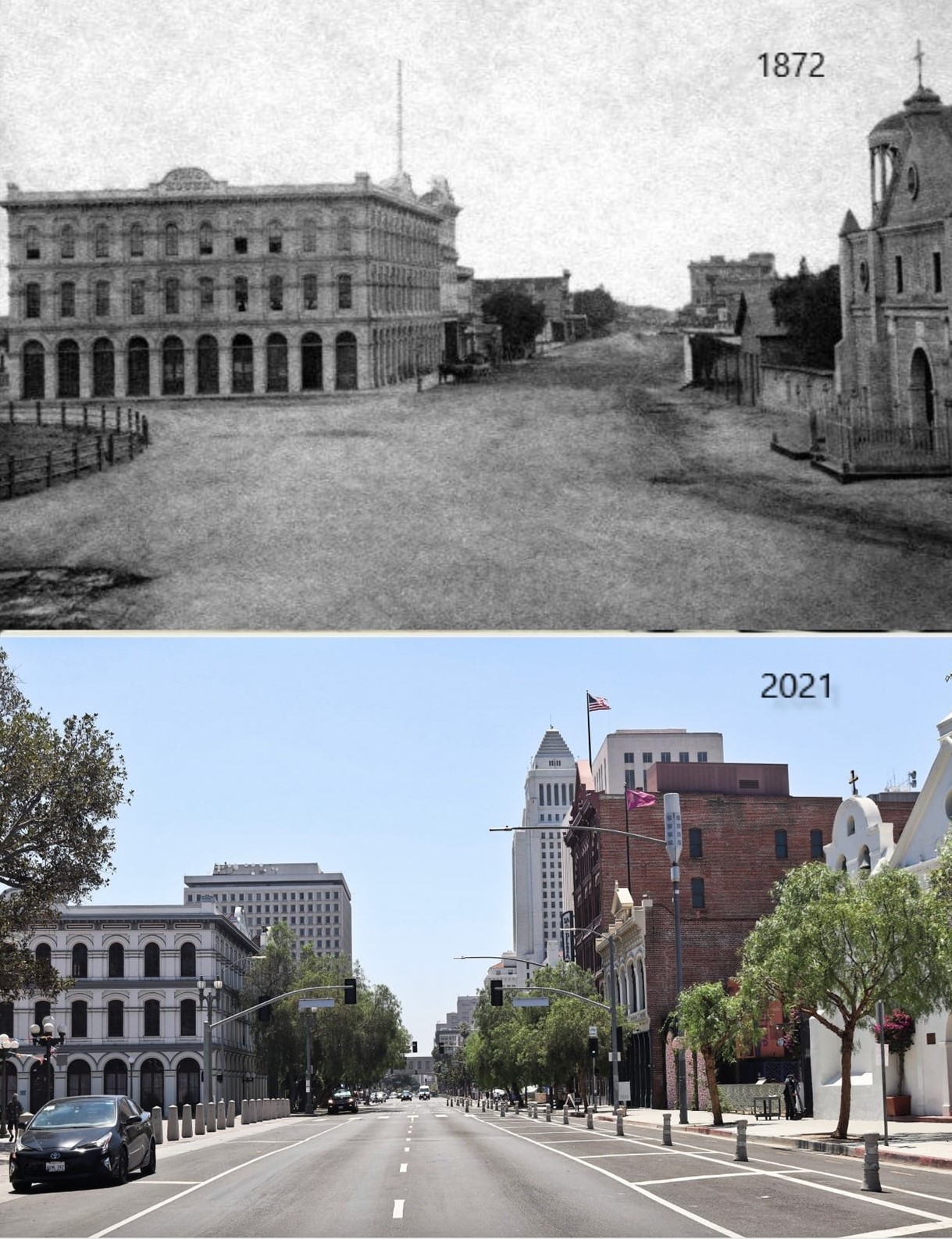 |
|
| (1872 vs 2021)* – Looking south on Main Street from in front of the LA Plaza. Three buildings still exist today: The Pico House and the Merced Theatre on the left, and the Plaza Church on the right. In the distance of the early photo can be seen the Temple Block, current site of Los Angeles City Hall. Photo courtesy of Mark Frazier. |
* * * * * |
Please Support Our CauseWater and Power Associates, Inc. is a non-profit, public service organization dedicated to preserving historical records and photos. Your generosity allows us to continue to disseminate knowledge of the rich and diverse multicultural history of the greater Los Angeles area; to serve as a resource of historical information; and to assist in the preservation of the city's historic records.
|
More Historical Early Views
Newest Additions
Early LA Buildings and City Views
History of Water and Electricity in Los Angeles
* * * * * |
References and Credits
* LA Public Library Image Archive
** DWP - LA Public Library Image Archive
++Vigilantism in Los Angeles (1853 - 1874)
***Photos of Vintage Los Angeles: Facebook.com
*^*California Historical Landmarks Listing (Los Angeles)
^*^Urban Diachrony: East side of North Main Street south of Arcadia Street
^*#California State Library Image Archive
*^ Wikipedia: Farmers and Merchants Bank of Los Angeles; Isaias Wolf Hellman
< Back
Menu
- Home
- Mission
- Museum
- Major Efforts
- Recent Newsletters
- Historical Op Ed Pieces
- Board Officers and Directors
- Mulholland/McCarthy Service Awards
- Positions on Owens Valley and the City of Los Angeles Issues
- Legislative Positions on
Water Issues
- Legislative Positions on
Energy Issues
- Membership
- Contact Us
- Search Index